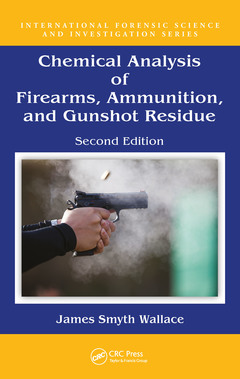Chemical Analysis of Firearms, Ammunition, and Gunshot Residue (2nd Ed.) International Forensic Science and Investigation Series
Auteur : Smyth Wallace James

Chemical Analysis of Firearms, Ammunition, and Gunshot Residue,Second Edition continues in the tradition of the popular first edition, filling the void in forensic texts on the subject. While most books on firearms focus solely on the physical aspects of firearms, this book addresses forensic issues relating to the chemical aspects of firearms and ammunition. It draws on the latest published literature including books, scientific papers, technical reports, manufacturer?s literature, newspaper articles, and personal observations and research conducted by the author.
This edition is fully updated, introducing the history and development of firearms and ammunition including advances in the chemical analysis of them. Several changes in primer compositions and the particle classification system are addressed with new techniques added on evidence collection and testing methods. Coverage details chemical aspects of forensic firearms casework with particular emphasis on the detection of gunshot residues (GSR), firearm discharge residues (FDR), and cartridge discharge residues (CDR) on a suspect?s skin and clothing surfaces. Two new chapters have been added. One deals with unusual firearms case while the other summarizes a controversial, high-profile Australian case involving inorganic and organic gunshot residue, highlighting the dangers of incorrect forensic evidence and the increased need for careful training of forensic scientists.
- Fully updated to reflect the latest techniques and tests for particle and chemical classification
- Provides a complete history of firearms and ammunition development as well as advances in the chemical analysis involved in forensic firearm casework
- Features a one-of-a-kind chapter on processing suspects, a crucial component in many firearms and explosives residue cases
The book will serves as a useful to forensic chemists, investigators, ballistics experts, among other professionals serving in a variety of forensic disciplines.
Part I. Introduction 1. Definitions Part II. Historical Aspects of Firearms and Ammunition 2. History of Gunpowder 3. History of Ignition Systems 4. History of Bullets 5. History of Ammunition 6. History of Firearms Part III. Chemical Aspects of Firearms and Ammunition 7. Cartridge Cases 8. Primer Cups (Caps) 9. Priming Compositions 10. Propellants 11. Projectiles 12. Complementary Ammunition Components 13. Caseless Ammunition 14. Blank Ammunition 15. Firearm Construction Materials Part IV. Firearm Discharge Residue Chapter 16. Firearm Discharge Residue Techniques 17. Properties of Firearm Discharge Residue Part V. Experimental 18. Scenes of Crime Experiences 19. Objectives, Sampling Procedures, Instrumentation, and Conditions 20. Particle Classification Scheme 21. Casework Related Tests 22. Analysis of Ammunition 23. Ammunition Containing Mercury 24. Lead Free Ammunition Part VI. Suspect Processing Procedures 25. Firearm Discharge Residue Sampling 26. Sampling of Skin and Clothing Surfaces for Firearm Discharge Residue 27. Development of a Method for Organic Firearm Discharge Residue Detection 28. Consequences of Incorrect GSR Evidence 29. Conclusion
Dr. James Smyth Wallace is a retired forensic scientist who worked in the firearms section of the Northern Ireland Forensic Science Laboratory for nearly 25 years. He worked numerous complex and controversial cases including a number of terrorist-related incidents. Previously a member of the Forensic Science Service, he is interested in quality assurance, crime scene examination, and all aspects of research in the development of chemical examinations relating to firearms casework.
Date de parution : 03-2021
15.6x23.4 cm
Date de parution : 06-2018
15.6x23.4 cm
Thèmes de Chemical Analysis of Firearms, Ammunition, and Gunshot... :
Mots-clés :
Flameless Atomic Absorption Spectrophotometry; Cartridge Cases; forensic chemistry; Firearm Discharge Residue; chemical analysis; Spent Cartridge Cases; gun violence; Mercury Fulminate; shooting incident; Discharge Residue; James Smyth Wallace; Primer Cup; Particle Analysis Method; Jacketed Bullets; Particle Classification Scheme; Shotgun Cartridges; Unjacketed Bullet; Potassium Chlorate; Discharge Particles; Explosive Residue; Suction Sampling; Head Stamp; Firearms Ammunition; Stannic Oxide; Close Range Shootings; Primer Composition; Black Powder; Firing Pin; Brass Cartridge Cases; EDX Examination



